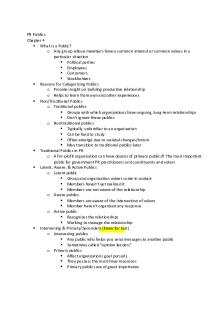Chapter 4 - Public Relations PDF

| Title | Chapter 4 - Public Relations |
|---|---|
| Course | Intro to Public Relations |
| Institution | University of Southern Indiana |
| Pages | 3 |
| File Size | 57 KB |
| File Type | |
| Total Downloads | 18 |
| Total Views | 158 |
Summary
Professor Erin Gilles...
Description
PR Publics Chapter 4 What is a Public? o Any group whose members have a common interest or common values in a particular situation Political parties Employees Consumers Stockholders Reasons for Categorizing Publics o Provide insight on building productive relationship o Helps to learn from own and other experiences Non/Traditional Publics o Traditional publics Groups with which organizations have ongoing, long-term relationships Don’t ignore these publics o Nontraditional publics Typically, unfamiliar to an organization Can be hard to study Often emerge due to societal changes/trends May transition to traditional publics later Traditional Publics in PR o A for-profit organization can have dozens of primary publics. The most important public for government PR practitioners and constituents and voters Latent, Aware, & Active Publics o Latent public Group and organization values come in contact Members haven’t yet realized it Members are not aware of the relationship o Aware publics Members are aware of the intersection of values Member haven’t organized any response o Active public Recognizes the relationships Working to manage the relationship Intervening & Primary/Secondary (know for test) o Intervening publics Any public who helps you send messages to another public Sometimes called “opinion leaders” o Primary publics Affect organizations goal pursuits They possess the must-have resources Primary publics are of great importance
o Secondary publics Minimal ability to affect organizations goal pursuit Practitioners build relationships if resources permit Internal/External Publics o Internal Inside your organization Employees are a primary internal public o External publics Outside your organization Can be a blurry distinction Example: alumni were internal as students, now external, but may still feel internal News media are external publics Domestic/International Publics o Domestic public Those within your own country o International publics Outside your country’s borders Cross-cultural considerations Blurred the line between the two groups Social media is erasing some boundaries Social Exchange Theory o An exchange of resources occurs in successful relationships. Each party gets something that they need or want. As long as the benefits exceed the costs, the relationship continues. Parties may be looking for a better relationship. Rewards – costs = profit Decision Makers o People who have the authority to dictate actions and establish policies for publics o May or may not be easily identifiable Especially true without organization Consumers Social media users Demographics o Provable data: Age, sex, income, education level, race, # of children… Psychographics o Data about what a public think, feels, and believes. Includes: political beliefs, religious beliefs, orientation toward technology, how they perceive money, etc. o Harder to collect than demographics – but valuable Co-orientation – 4 questions o What is our organizations view of this issue? o What is the particular public’s view of this issue?
o What does our organization think the public’s view is? o What does the particular public think our organization’s view is? Employee Publics o Job satisfaction in United States 81% - overall satisfaction with their current job 83% - are determined to accomplish work goals 79% - have satisfactory co-worker relationship o Foundations of U.S. job satisfaction One-quarter of employees feel overworked One-third report lack of supervisor support 60% not highly engaged in their job duties Employee Publics o The most important public Employees are the most important public Employee desire for better supervisors o Millennials’ top values in life Being a good parent Having a successful marriage Helping others in need Owning a home Living a religious life...
Similar Free PDFs

Chapter 4 - Public Relations
- 3 Pages

Public relations
- 60 Pages

Public relations
- 15 Pages

Public Relations
- 24 Pages

Kampanye Public Relations
- 154 Pages

Sports public relations
- 3 Pages

AMB263 Public Relations A1
- 4 Pages

Public relations theory
- 11 Pages

Professional Public Relations
- 199 Pages

Mastering Public Relations
- 188 Pages

Public Relations - Syllabus
- 5 Pages

Public Relations Assignment
- 3 Pages

DIGITAL PUBLIC RELATIONS
- 10 Pages

Public Relations Theories-ppt
- 26 Pages

Public Relations week 1 notes
- 3 Pages
Popular Institutions
- Tinajero National High School - Annex
- Politeknik Caltex Riau
- Yokohama City University
- SGT University
- University of Al-Qadisiyah
- Divine Word College of Vigan
- Techniek College Rotterdam
- Universidade de Santiago
- Universiti Teknologi MARA Cawangan Johor Kampus Pasir Gudang
- Poltekkes Kemenkes Yogyakarta
- Baguio City National High School
- Colegio san marcos
- preparatoria uno
- Centro de Bachillerato Tecnológico Industrial y de Servicios No. 107
- Dalian Maritime University
- Quang Trung Secondary School
- Colegio Tecnológico en Informática
- Corporación Regional de Educación Superior
- Grupo CEDVA
- Dar Al Uloom University
- Centro de Estudios Preuniversitarios de la Universidad Nacional de Ingeniería
- 上智大学
- Aakash International School, Nuna Majara
- San Felipe Neri Catholic School
- Kang Chiao International School - New Taipei City
- Misamis Occidental National High School
- Institución Educativa Escuela Normal Juan Ladrilleros
- Kolehiyo ng Pantukan
- Batanes State College
- Instituto Continental
- Sekolah Menengah Kejuruan Kesehatan Kaltara (Tarakan)
- Colegio de La Inmaculada Concepcion - Cebu
